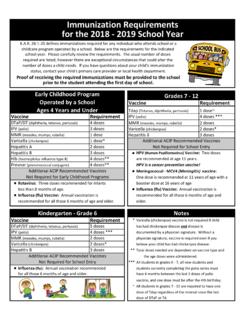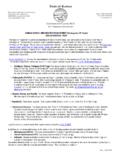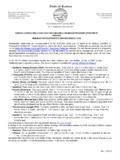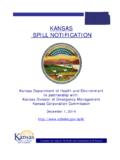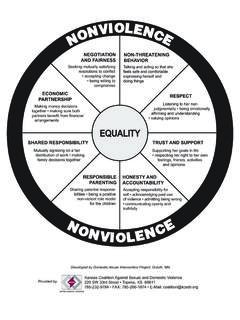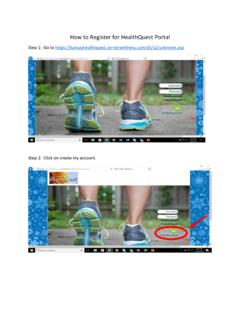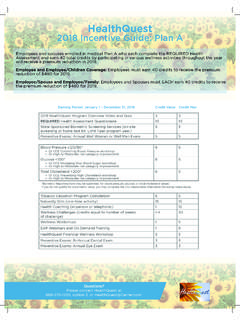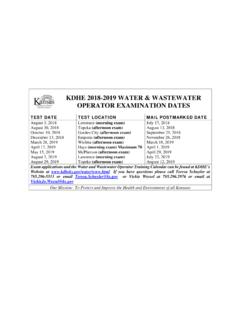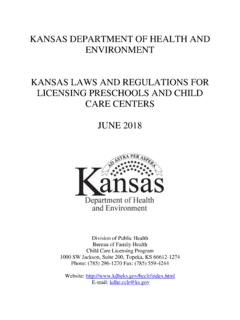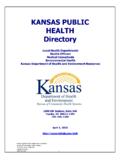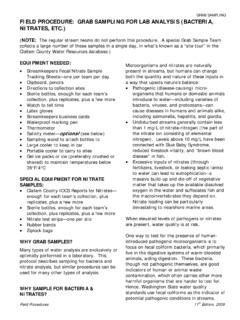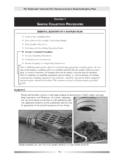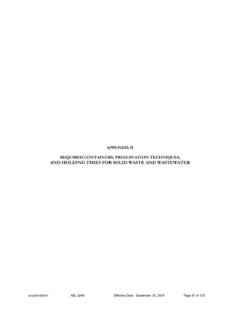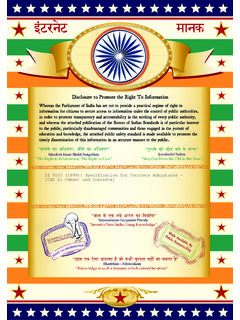Transcription of 'Indoor Radon and Radon Decay Product …
1 "Indoor Radon and Radon Decay Product measurement Device Protocols" Environmental Protection Agency Office of Air and Radiation (6604J) EPA 402-R-92-004, July 1992 (revised) Table of Contents Disclaimer Acknowledgements Significant Changes in This Revision Radon and Radon Decay Product measurement Methods Section 1: General Considerations Introduction and Background General Guidance on measurement Strategy, measurement Conditions, Device Location Selection, and Documentation Quality Assurance Section 2: Indoor Radon measurement Device Protocols Protocol for Using Continuous Radon Monitors (CR) to Measure Indoor Radon Concentrations Protocol for Using Alpha Track Detectors (AT or ATD) to Measure Indoor Radon Concentrations Protocol for Using Activated Charcoal Adsorption devices (AC) to Measure Indoor Radon Concentrations Protocol for Using Charcoal Liquid Scintillation (LS) devices to Measure Indoor Radon Concentrations Protocol for Using Grab Radon Sampling (GB, GC, GS), Pump/Collapsible Bag devices (PB), and Three-Day Integrating Evacuated Scintillation Cells (SC)
2 To Measure Indoor Radon Concentrations Interim Protocol for Using Unfiltered Track Detectors (UT) to Measure Indoor Radon Concentrations Section 3: Indoor Radon Decay Product measurement Device Protocols Protocol for Using Continuous Working Level Monitors (CW) to Measure Indoor Radon Decay Product Concentrations Protocol for Using Radon Progeny Integrating Sampling Units (RPISU or RP) to Measure Indoor Radon Decay Product Concentrations Protocol for Using Grab Sampling-Working Level (GW) to Measure Indoor Radon Decay Product Concentrations Glossary References Please Note: EPA closed its National Radon Proficiency Program (RPP) in 1998.
3 Please check our proficiency page for more information on how to find a qualified Radon service professional. The information in this document which refer to companies, individuals or test devices that "meet EPA's requirements", or "EPA ", or refers to EPA's old RPP designations "RMP or RCP" is no longer applicable. This document is in need of revision to reflect the closure of EPA's old RPP. Our proficiency page has information how to find qualified Radon service professionals. Disclaimer While we try to keep the information timely and accurate, we make no expressed or implied guarantees. We will make every effort to correct errors brought to our attention. The material and descriptions compiled for these pages are not to be considered Agency guidance, policy, or any part of any rule-making effort but are provided for informational and discussion purposes only.
4 They are not intended, nor can they be relied upon, to create any rights enforceable by any party in litigation with the United States. Acknowledgements This document represents the cumulative efforts of many dedicated individuals within the Radon measurement community and the Environmental Protection Agency. Several key components of this document were prepared by the authors acting as interpreters of the substantial field experience and technical knowledge provided by these individuals, and their assistance is gratefully acknowledged. Significant Changes in this Revision This protocol document updates and supersedes the Environmental Protection Agency (EPA) document entitled, "Indoor Radon and Radon Decay Product measurement Protocols," and issued in March, 1989 ( EPA 1989a).
5 The updating reflects new information, new procedures, and new measurement devices , including a new interim protocol for unfiltered track detectors. The EPA's testing recommendations are summarized in Section This measurement strategy reflects the changes made in the most recent edition of "A Citizen's Guide to Radon " ( EPA 1992a). More information is also provided in the EPA measurement guidance document, "Protocols for Radon and Radon Decay Product Measurements in Homes" ( EPA 1992c). Guidance on Radon measurements in schools and for real estate transactions is also available ( EPA 1989b, 1992b). This edition contains some clarifications and new information on quality assurance. The addition of a Glossary provides definitions and formulas for several of the technical terms used in the document, including accuracy, precision, and the values used to quantify these parameters.
6 The two previous editions of these protocols ( EPA 1986, 1989a) used the value coefficient of variation (COV), defined as the standard deviation divided by the mean, as the expression used for the goal (at 4 pCi/L or WL) of 10 percent for precision. The COV should decrease with increasing concentration. This edition explains that there is a variety of ways to calculate and express precision, including the COV and the relative percent difference, defined as the difference between two duplicates divided by their mean. It is important to monitor precision over the entire range of Radon levels that are encountered routinely in the measurement program, and that a systematic and documented method for evaluating changes in precision be part of the standard operating procedures. While a limited precision error is desirable ( , COV of < 10% at 4 pCi/L), it is most important to maintain the total error of any individual device (including both errors in precision and accuracy) to within 25 percent of the "true" Radon or Decay Product concentration for concentrations at or above 4 pCi/L ( Working Levels when the equilibrium ratio is ).
7 To limit errors in accuracy, this edition recommends that users calibrate their measurement systems at least once every 12 months. Participation in the former National Radon measurement Proficiency (RMP) Program did not satisfy the need for annual calibration, as this Program was a performance test, not a calibration procedure. The 1986 and 1989 versions of the measurement protocols recommended that known exposure measurements, or spikes, be conducted at a rate of a few percent of the total number of measurements. These measurements are those for which the detectors are exposed to a known Radon concentration in a calibration chamber and analyzed routinely. The results are used to monitor the accuracy of the entire system. This edition clarifies this recommendation, specifying that spikes be conducted at a rate of three per 100 measurements, with a minimum of three per year and a maximum required of six per month.
8 This reduces the number of spikes necessary for large users and clarifies the need for spikes by all users. A significant change in this version of the measurement Protocols is the requirement that all devices used for measurements in homes, schools, or workplaces be deployed for a minimum of 48 contiguous hours. It is important to understand that this minimum measurement period applies to all cases when the result of the measurement is given to a homeowner or building official to determine the need for further measurements or remedial action. The exceptions to the 48-hour measurement period are for those cases when the results will not be reported to a homeowner or building official, but will be used by a mitigator or researcher within the context of their project or research. For example, in-progress diagnostic measurements made in the process of performing mitigation can help to determine points of Radon influx.
9 Results of these measurements will be used to assist the contractor to better understand the dynamics of Radon within that building, and will be part of a series of measurements, including pre- and post-mitigation 48-hour measurements. Radon researchers testing the effects of mitigation techniques, measurements methods, or strategies may also need to perform measurements of flexible durations. The Agency has implemented a requirement for a minimum measurement period for several reasons. First, it will help ensure consistency among measurement programs, thereby ensuring that measurement results of at least a minimum quality become the basis for decisions by homeowners, school officials, and others responsible for authorizing further measurements or mitigation. This will become increasingly important as Radon is measured in more and different types of buildings, and as a more diverse group of people, many without technical backgrounds, find the need to compare and understand these results.
10 Second, a minimum measurement period will guarantee that a certain number of hours, including daily Radon cycles, will be incorporated into the result reported to the persons responsible for making a decision about that building. A period of 48 hours for the minimum measurement period is a policy decision that was arrived at after careful scrutiny of the possible options. It is important that the complete measurement result includes the effects of daily fluctuations in Radon levels, so the minimum period needed to be a multiple of a 24-hour day. The Agency deems a single 24-hour period as too short because of the possibility of unforeseen circumstances occurring during the 24 hours; this possibility is diminished if two 24-hour periods form the duration of the measurement . One possible unforeseen circumstance is the improper implementation of closed-building conditions.
